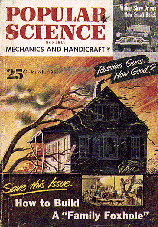Activity 1
Essential Question
- How do clashes of ideology impact governments and how people live?
Background
The Cold War had a powerful impact upon policies of government and upon people's lives. Nations divided over which side they favored in the Cold War, that of the United States or that of the Soviet Union. Nations often gained favors for supporting one side or the other. In some cases, both the Soviet Union and the United States supported dictatorships so long as those dictatorships took their sides in the Cold War, and human rights suffered as a result. In the United States, people read and worried very much about developments in the Cold War, whether this nation was taking adequate steps to fight communism, whether this nation was taking away people's freedoms in the name of fighting communism, whether children were being poisoned by radioactive fallout from nuclear tests, and whether to include "fallout shelters" in new homes they were building. The Cold War had a profound effect upon governments, families, and individuals.

Instructional Strategies
 |
Strategy 1 |
Using Video Clips to Research Information
Use the following websites for students to learn about the participants in the cold war.
CNN Cold War Series Video Clips
As they view the video clips, ask them to think about:
- The role of the various participants in the Cold War
- Their key actions
- The motivation for their actions.
Have them narrow their focus to these key individuals:
- President Richard Nixon
- Leonid Brezhnev
- Deng Xiaoping
- Mikhail Gorbachev
- Journalists
- Teachers
- Students
Have the students complete the Structured Viewing Sheet as they view the video clips. Use the viewing sheet as a summary of the information students have learned from the video clips. Have individual students come to the front of the room to talk about what they have learned about one of the people or groups on the list.
Check for Understanding |
 Printable
Student View Printable
Student View |
Narrow focus to these key individuals:
- President Richard Nixon
- Leonid Brezhnev
- Deng Xiaoping
- Mikhail Gorbachev
- Journalists
- Teachers
- Students
- Who were the major participants in the Cold War?
- What were their key actions?
- What was the motivation for their actions?
Have the students assume the role of one of the individuals and have them address the class as if they were responding to these questions in the first person.
 |
Strategy 2 |
Triptych (three-panel) Poster Exhibition: "The Beginnings of the Cold War"
- Tell the students that they will use their computer research as they work in teams to create triptych posters for a special exhibition entitled "The Beginnings of the Cold War." The audience for the exhibition will include classmates, students from other classes, parents, other people from the community, and historians from nearby colleges and universities.
- Tell them that they can choose from nine topics and that they will be working as a team on two or three.
- Print out the topics and allow students to form teams (or assign teams) and talk about which topic they would like to do. Talk about the importance of each topic and be sure all topics are covered as teams make their selections.
- Tell students that this is an ongoing project throughout the course of the unit and that they will be expected to find additional information from other sources including the media center and from class discussions.
- Tell students that all projects sources used in the research, which must be a mix of print and Internet resources, are to be listed on the back of each triptych.
- Focus Sheet on the Cold War
Check for Understanding |
 Printable
Student View Printable
Student View |
- Students will present an exhibition of the posters.
- A key activity of the exhibition will be a "tour" by each learning group of the other nine projects. Students will ask questions of each group using a Focus Sheet to guide the discussion. This will provide an opportunity for each group to present their project to others and demonstrate their understanding of their own project. As they visit other projects they will also see how their project fits into the total picture of the Cold War Era.
- One of the most important questions to be asked in the "tour" is that of which source(s) did your team find to be the most useful and why?

 All Modules
All Modules Printable View
Printable View
 Scoring Guide
Scoring Guide